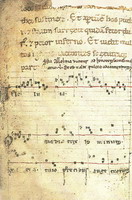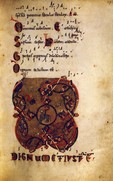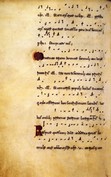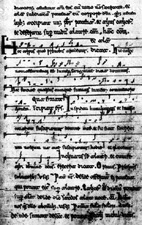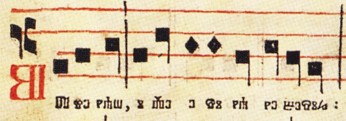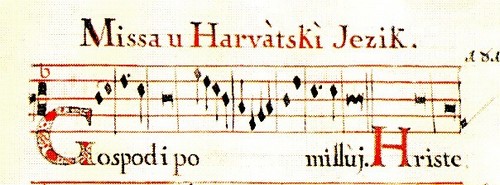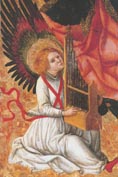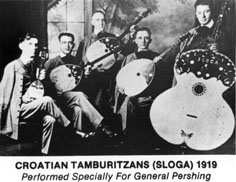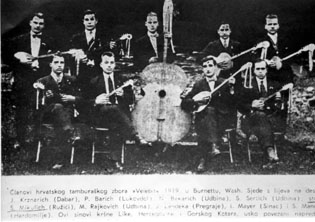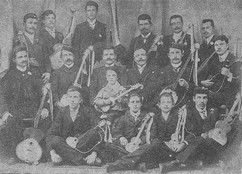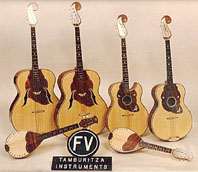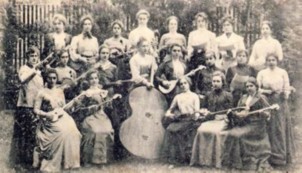SIESC 2007 in CROATIA
European Federation of
Christian Teachers
Fédération Européenne d'Enseignants
Chrétiens
Europäische Föderation Christlicher Lehrer/innen
You
cannot report on half a century in a few pages...
Yves CALAIS, see History
of SIESC
An attempt to briefly
describe some achievements of
Croatian Music
Darko Zubrinic, Zagreb
An
age is known by its music
Croatian proverb (see [Kuhac])
 The
first Croatian neum manuscripts for church music date from the 11th
century. The Osor Evangelistary
(1080-1082) from the convent of st. Nikola in Osor (island of Cres) is
written in beneventana, ornamented by Monte Cassino initials, and
accompanied with old neums. This evangelistary contains among others a
prayer for the Pope, for Byzantine tsar, and for the King which at that
time was factual ruler of Osor (regis nostri) - Croatian King Zvonimir.
The evangelistry is held in the Vatican Archives. Some of the Christmas
folk songs from the 12th century are still very popular. It is
interesting that the Croats have more than 500 (five hundred) Christmas
carols. There are Christmas verses that can have a dozen of different
melodies, varying considerably from region to region. The number of Croatian Christmas carols
is surprisingly large even in world's proportions.
The
first Croatian neum manuscripts for church music date from the 11th
century. The Osor Evangelistary
(1080-1082) from the convent of st. Nikola in Osor (island of Cres) is
written in beneventana, ornamented by Monte Cassino initials, and
accompanied with old neums. This evangelistary contains among others a
prayer for the Pope, for Byzantine tsar, and for the King which at that
time was factual ruler of Osor (regis nostri) - Croatian King Zvonimir.
The evangelistry is held in the Vatican Archives. Some of the Christmas
folk songs from the 12th century are still very popular. It is
interesting that the Croats have more than 500 (five hundred) Christmas
carols. There are Christmas verses that can have a dozen of different
melodies, varying considerably from region to region. The number of Croatian Christmas carols
is surprisingly large even in world's proportions.
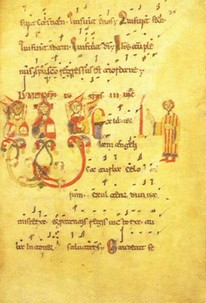
Miho Demovic, a Croatian musicologist, discovered some old partitures in the Vatican archives originatin from the territory of Croatia. Together with Hortus Musicus (Tallin Estonia), two concerts were organized within The Osor Musical Evenings, entitled Music in Croatia from 8th to 10th centuries, and Music in Croatia from 10th to 12th centuries. See here, and also Miho Demoviæ: Liturgijski recitativi iz starih hrvatskih kodeksa od X. do XII. stoljeæa, Zagreb, Kor Prvostolne Crkve Zagrebaèke, 2000, ISBN 9005208-5-2, 400526039
The Cika Breviary
from 11th century is important monument of Croatian culture written in
the Benedictine Monastery of St. Krsevan in Zadar. It also contains
musical notation, and is kept in Budapest in the Library of the
Hungarian Academy of Sciences.
Vekenega
Evangelistary, a top monument of
Croatian culture, is a richly illuminated Latin text from the 11th
century. It has been written in the famous Benedictine
monastery of St
Krsevan, and is kept today in
the Bodleian Library in Oxford. Below you can see the neums accompaning
the text.
Very old and valuable is the Dubrovnik Missal from 12th century, now kept in the Bodleian Library in Oxford. Written in Latin, in Beneventan script, it contains prayers and some chants unique in Europe. See [Menalo, pp. 34-35], and also Dubrovnik.
The Croats can boast of having two excellent Renaissance composers. The first one is Julije Skjavetic (Schiavetti) from the 16th century. Between 1557 and 1573 he lived in Sibenik, and was conducting a choir in the famous Sibenik Cathedral. He wrote a collection of madrigals for 4-5 voices and a collection of motets for 5-6 voices (both published in Venice in 1563 and 1564 respectively). An important collection of his motets that was held in Dresden, disappeared after the destruction of the city in 1945. Luckily, it was discovered in Krakow in 1993.
Ivan Lukacic (1584-1648), a Renaissance composer born in Sibenik, was conductor and organist in the Split Cathedral. In 1620 he published a collection Sacrae cantiones, containing 27 motets for 1-5 voices accompanied by organs. Lukacic's collection was lost in the course of WW2, and rediscovered in the 1980's at the Jagiellon Library in Krakow, Poland. This is the only known copy.
Otce
nas (Our Father) in the
Glagolitic,
Levakovic's Glagolitic
Missal, Rome 1631
Misa u Harvatski Jezik (= Mass in Croatian Language) ,
kept in the Franciscan convent in Sinj, 1644
A true jewel of Croatian culture is Pavlinski zbornik (Paulist collection) from 1644, a collection of church chants. It is important in its language, text and sheet music. Paulists left important traces in Croatian culture during five centuries of their presence in Croatian lands from 13th to 18th centuries, see [Sekulic].
Luka Sorkocevic (1734-1789), whose beautiful symphonies are performed throughout the world, lived in Dubrovnik. The opening melody to this web page is his Allegro.
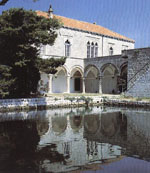
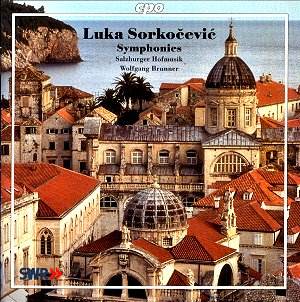
You can see a detail from the Dubrovnik polyptich by Lovro Dobricevic from 1466, representing an angel playing portative, a small portable organ:
The verses for the Croatian national anthem Our Beautiful Homeland (Lijepa nasa domovino) were written by a Croatian poet and diplomat Antun Mihanovic (1796-1861).
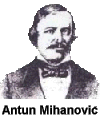
The music was composed by Josip Runjanin (1821-1878). It is interesting that many Croats who sang it during the former Yugoslav regime (for example on country weddings), risked to be imprisoned. There was a jail not far from Zagreb, nicknamed as "Jail for Singers'' (see [Macan, Sentija]).
Our Beautiful Homeland
Beautiful
is our homeland,
O so fearless, o so gracious,
Our fathers' ancient glory,
May God bless you, live forever!
You are
our only glory,
You are our only treasure,
Yes, we love your plains and valleys,
Yes we love your hills and mountains.
Sava,
Drava, keep on flowing,
Danube, do not lose your vigor,
Deep blue sea go tell the whole world,
That a Croat loves his homeland.
When his
fields are kissed by
sunshine,
When his oaks are whipped by wild winds,
When his dear ones go to heaven,
Still his heart beats for Croatia!
A famous Ukrainian linguist Agatangel Efimovic Krimski, or Agatangel Kryms'kij (1871-1942), founder of the Ukrainian Academy of Sciences, and its lifelong president, suggested during the 1934 Congress of Soviet writers that the USSR national anthem should be composed according to Croatian anthem.
The verses for the Austrian national anthem "Land der Berge, Land am Storme", were written by Paula von Preradovic (1887-1951), Austrian writer and poetess, grand-daughter of the Croatian poet Petar Preradovic (1818-1872), with the music of W.A. Mozart.

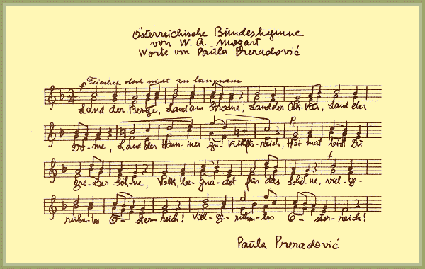
| Land
der Berge, Land der Ströme, Land der Äcker, Land der Döme, Land der Hämmer, zukunftsreich. Heimat bist du grosser Söhne, Volk begnadet für das Schöne, Vielgerühmtes Österreich, Vielgerühmtes Österreich! Heiss umfehdet, wild umstritten, Mutig in die neuen Zeiten, |
Land
of mountains, land on the river, Land of fields, land of cathedrals, Land of hammers, rich in outlook. You are the native home of great sons, A people uniquely gifted for the beautiful, Much applauded Austria. Fiercely embattled, ferociously
contested, Courageously we stride |
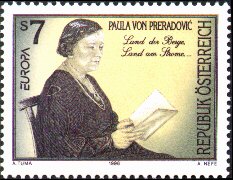
Paula von Preradovic on Austrian postage stamp, issued in 1996
She wrote a lot about Croatia, its people, history and nature, for example "Königslegende" in 1950, "Pave und Pero" in 1940, and "Dalmatinische Sonette" in 1933.
- It is interesting that Paula von Preradovic's verses were chosen among as many as 1800 entries submitted for the Austrian national anthem in 1947.
- When Paula von Preradovic died in 1951, the Wiener Sanger Knaben (The Vienna Boy Choir) sang the Austrian national anthem on the funeral, with her verses.
- Paula von Preradovic: Gesamelte Werke, Verlag Fritz Molden (her son), Wien, 1967.
- Austrian Bundespresident Dr. Thomas Klestil: ...Ich glaube, die knappste Beschreibung der Geschichte und der Zukunft unseres Landes verdanken wir nach wie vor Paula von Preradovic, der Dichterin unserer Bundeshymne. Dort heisst es - mit dem Blick über tausend Jahre hinweg - in der zweiten Strophe: "Heiss umfehdet, wild umstritten liegst dem Erdteil Du inmitten - einem starken Herzen gleich!" So ist es - und so muss es bleiben. (1996)
The first national operas among the Slavs were composed by Russians (M. I. Glinka, 1836, 1842), then the Croats follow immediately. Vatroslav Lisinski composed the first Croatian national opera "Ljubav i zloba" ("Love and malice") in 1846. Then follow the Czechs (B. Smetana in 1862), and these three nations are the only ones among the Slavs who have national operas.
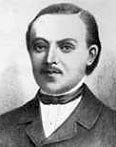
Let us mention that Franz Liszt gave piano concerts in Zagreb (see here, in Croatian) and in Samobor, a lovely nearby town, in 1846. Operas composed by Ivan Zajc (1832-1914) and Jakov Gotovac (1895-1982) are performed in concert halls throughout the world. The most famous opera of Jakov Gotovac is Ero s onoga svijeta, which has been translated into 9 languages and performed in about 80 countries.
We cannot avoid the fact that some outstanding historians of Croatian music (like Lovro Zupanovic, Ennio Stipcevic) prove that the first Croatian opera was composed almost 80 years earlier than "Ljubav i zloba" by Lisinski. The name of the composer is Julije Bajamonti (1744-1800). In 1796 he wrote an article "Il medico e la musica" ("The physician and music"), an essay on musical therapy, one of the first in history, in which he showed that music has therapeutic strength. He was the most versatile and fertile Croatian composer of the time (230 compositions, some of them fragmentary). Bajamonti composed sacred music for verses in Latin, Italian, and Croatian: for example La passione de Gesu Cristo (cantata to words of Pietro Metastasio), Requiem (composed on the occasion of death of Rugjer Boskovic, commissioned by the Dubrovnik Senat in 1787), Spiritual songs to Croatian verses. In 1767 he composed an oratorio which represents the first Croatian opera, and according to Lovro Zupanovic, the most beautiful work of its time in this country. He also wrote the first Croatian oratory (La translation di San Diomo), one of the highest achievements of Croatian 18th century music.
Franjo Dugan (1874-1948), studied mathematics and physics, and was outstanding organ player and composer, the Zagreb Cathedral organist since 1910. It is maybe worth mentioning that the French pianist Alfred Brendel, at that time 10 years old, met Dugan in Zagreb, who gave him lessons that he found extremely useful.
Rudolph Matz (1901-1988) is perhaps the greatest cello theoretician in the world (opinion expressed by Leonard Rose). He wrote manuals for cellists that even today are considered among the best for young cellists throughout the world. Matz studied cello, composition and conducting at the Zagreb Academy of Music, and became professor of cello at the University of Zagreb in 1950, where he stayed until his retirement in 1972. He wrote about 300 vocal and instrumental compositions, about 100 of them for cello. He is the author of the monumental 32 volume Prve godine violoncella - First Years of Violoncello. He also wrote the widely used For Young Hands, 54 Short Etudes.
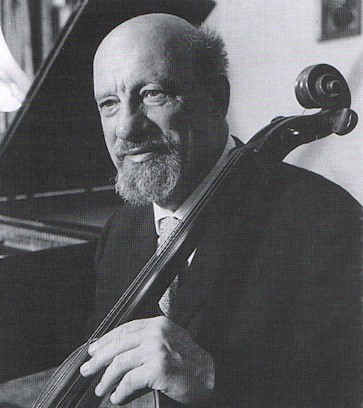
Rudolf Matz, photo from Physicians Singers of Zagreb
Rudolph Matz was a top Croatian sportsman. As a sprinter he won the first place in the Prague in 1921, beating also German sprinters. He was a record holder in Croatia on 100 (for 11 years!), 200, 4x100, and 400 m. He stressed that the work of a music educator is similar to that of a trainer.
Matz served as a jury member at the International Tchaikovsky Competition in 1966, 1970 and 1974, and at Gaspar Cassado's competition in Florence in 1973. Matz was also a pioneer in establishing the field of music therapy as a profession in Croatia. He founded among other the Zagreb Chamber Orchestra, predecessor of the Zagreb Soloists (I Solisti di Zagreb). Since 1996 an annual International Competition Rudolph Matz is held in Dubrovnik organized by Croatian String Teachers' Association.
Any admirer of classical music certainly knows the Zagreb Soloists, conducted by maestro Tonko Ninic (until 1997).

![]()



- The Zagreb Philharmonic Orchestra,
- The
Zagreb String Quartet, founded
in 1919, which performed about 5,000 concerts until the end of 20th
century, many of them throughout the world,
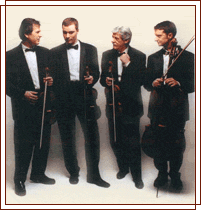
- Dora
Pejacevic (1885-1923) is the
first important female composer in Croatia; in her short life she left
behind her a rich opus of 58 pieces; she was portrayed among others by Maximilian Vanka,

Dora Pejacevic: Allegro, [wma] 9.2 MB,
live performance in the chapel of Prandau - Normann palace, Valpovo, 2005,
Mirta Pletersek-Blaskovic (violin) and Petra Gilmung (piano), with kind permission - Krsto Odak (1888-1961), important Croatian composer of sacral music, in particular church music inspired with old Croatian glagolitic texts.
- the
violinist Zlatko Balokovic
(1895-1965); he was in possession of Guarneri's famous violin "the
King" from 1735 (one of the last violins built by Giuseppe Guarneri del
Gesù, "the King" was named in honour of King Joseph of
Hapsburg, estimated to nine million dollars); he donated "the King" to
his beloved city of Zagreb in 1964;
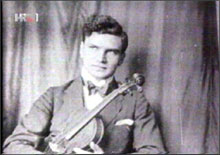
 Guarneri's famous violin"the King" from 1735,
Guarneri's famous violin"the King" from 1735,
donated by Zlatko Balokovic to the city of Zagreb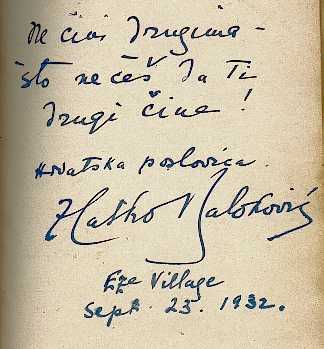
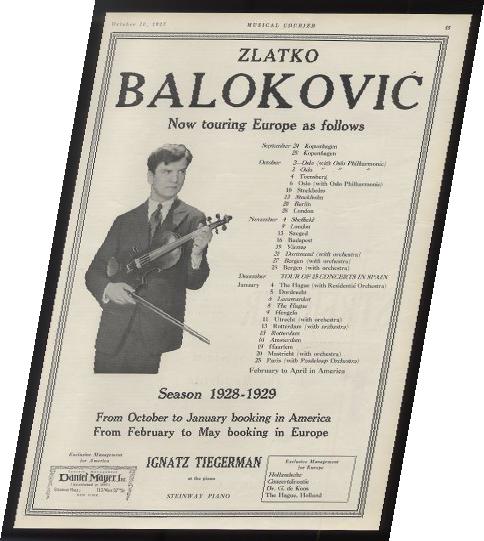
Balokovic's series of concerts in Kopehnagen, Oslo, Stockholm, Berlin, Budapest, Vienna, Dortmund, The Hague, Utrecht, Amsterdam, Maastricht, Paris, 1928-1929.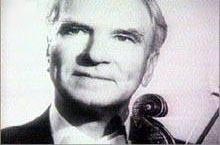
- Lovro
von Matacic, one of the greatest
conductors of the 20th century (1899-1985), started his career in 1919
as conductor of orchestras in Osijek, Novi Sad, Ljubljana, Belgrade,
Riga, and in Zagreb in 1932. From 1942-1945 he was conductor of the
Vienna Opera. After 1945 he was imprisoned by the Yugoslav communist
regime, and together with Croatian poet Tin Ujevic and painter Kristian Krekovic
sentenced to confiscation of all movable and immovable property. In
1950's he became organizer of Festivals in Dubrovnik and Split. In 1956
Matacic moved to Germany to conduct East Berlin Opera and the famous
Dresden Staatskapelle, then conducted at Bayreuth in 1959, and from
1961 to 1966 was Gereralmuikdirektor in Frankfurt. He was also guest
conductor in Vienna Opera, Milan Scala, in Chicago, Naples, Palermo,
Rome, London, Cleveland, Tokyo, Prague, etc., and was elected the
honorary director of the Japanese Orchestra in Tokyo. From 1970 to 1980
he was conductor and artistic director of the Zagreb Philharmonic
Orchestra, and almost simultaneously from 1973 to 1979 had the same
role in the Monte Carlo Orchestra.
Lovro Matacic is laureate of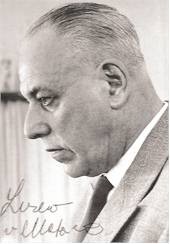
- the Bruckner Medal and of the International Bruckner Society, recipient of the Bruckner Ring from Viennese Symphonic Orchestra (one among only a few of the most outstanding conductors),
- recipient of the Smetana Medal from the Czech government and Janacek Medal,
- Hans von Bellow Medal from the Berlin Philharmonic Orchestra,
- medal for artistic work from the Prince Rainer of Monaco,
- the Cross of the First Order for Science and Art from the president of Republic of Austria,
- and of numerous recognitions in Croatia.
Milka Trnina (or Ternina, 1863-1941) was a famous Croatian opera singer. According to Giacomo Puccini, author of the famous opera Tosca, she was the best "Tosca" that he had opportunity to listen to (on the London première in 1900); see Milka Ternina at the Royal Opera House, Covent Garden. Only in Convent Garden in London Milka had 56 performances between 1895 and 1906. Also, she was the first Tosca in Great Britain and in the United States.
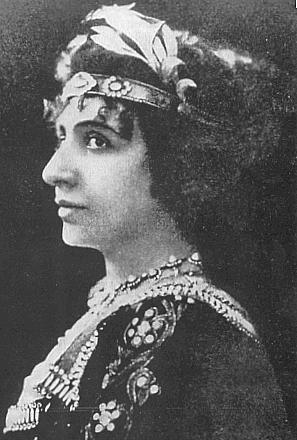
Saviez vous que le célébre chocolat porte le nom de "Milka" en l'honneur de Milka Trnina, chanteuse d'opéra originaire d'Ivanic Grad en Croatie. Le fondateur de la marque étant un admirateur de la diva croate, il décida de donner son nom, Milka, a son entreprise et son chocolat.

Mia Slavenska (born in Slavonski Brod, 1914-2002), became ballerina of the Zagreb Opera (1930-33), studied also in Vienna, and joined the Paris Opera in 1933. In London she danced with Anton Dolin before joining the Ballet Russe de Monte Carlo (1938-42). She later formed her own company, Ballet Variante. In 1953 she established the Slavenska-Franklin ballet company with Frederic Franklin. In 1950's she was prima ballerina of the Metropolitan Opera in New York. By the end of her career she was teaching in Los Angeles, California. Slavenska starred in a wonderful French film, La Mort du Cygne (1938).

www.slavenskadancepreservation.org
Albe Vidakovic (1914 - 1964), born in the town of Subotica in Backa, was an important composer of Croatian church music. He also collected Croatian musical folklore. The Institute for Church Music in Zagreb is named after him. He belonged to Bunjevci Croats around the city of Subotica. Bunjevci Croats are recognizable by their beautiful ikavian dialect and folklore which is very close to that of Croatian north-east. When he was born, Subotica was the city with the second largest number of Croats after Zagreb, our capital. Even more interesting is the fact that in the period 1900-1904 Subotica was the largest Croatian city, with more Croats than Croatian capital Zagreb!
The Dubrovnik Summer Festival, which puts on dramatic, music and ballet art, was founded in 1950. A special attention is devoted to the plays of Marin Drzic and William Shakespeare. Especially famous is the Hamlet performance on the old tower of Lovrijenac. Due to its exceptional ambience, offering enormously powerful aesthetic experiences, it is regarded to be the best stage for Hamlet in Europe.
Monika Leskovar (1981), Croatian violoncellist, was the winner of the prestigiousTchaikovsky competition in Japan for 1995. She won the third prize at the 1997 Rostropovic competition in Paris, the second prize at the 1998 Eurovision contest for young instrumentalists, winner of the 1999 Roberto Caruana competition in Milano, Italy, the second prize at the famous ARD competition in 2001.

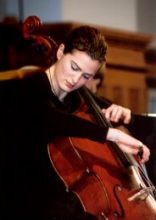
A
well known Croatian pianist is Ivo
Pogorelic (1958).
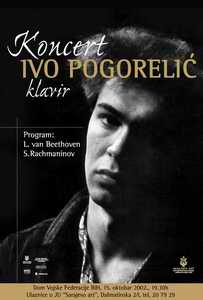
Radovan Vlatkovic (1962) is a distinguished horn soloist, playing in the Philharmonic Orchestra of Berlin.
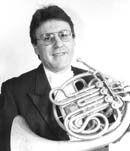
Ana Vidovic (1980) is a brilliant guitarists. She won the 1998 International Guitarist Competition "Francisco Tarrega" in Benicasim, Spain, among forty competitors up to the age 32, see Toutes les qualités d'une jeune virtuose at Societé luxembourgeoise de guitare classique. She also won first prizes at "Albert Augustinum International Competition" in Bath, England, at the "Ferdinando Sor Competition" in Rome. She had concerts in London, Paris, Vienna, Salzburg, Rome, Budapest, Warsaw, Tel Aviv, Copenhagen, Tronto, San Francisco, Houston, Austin, Dallas, St Luis. More information at vidovic.com.
Watch and listen to Ana's concert
in the Kennedy Center
in Washington DC, 2004.
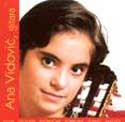
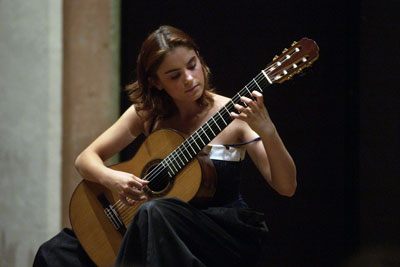
Katarina Livljanic founded a French international Dialogos Ensemble in Paris in 1996. This vocal ensemble has singers from Norway, Venezuela, Bulgaria, Sweden, France and Croatia, specialized for Middle Age music and liturgical tradition among Mediterranean cultures. Their program includes also old Croatian glagolitic singing from Istria and very archaic singing from the island of Hvar. The glagolitic chant from medieval Croatia has been performed and recorded with great musicological interest.

![]()
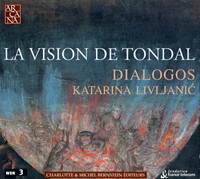
Photos from www.ensemble-dialogos.org
In 1999 a CD Terra Adriatica was issued, under the title Chants sacrés des terres croates et italiennes au Moyen-Age, Dialogos Ensemble/Katarina Livljanic, Paris, ED 13107. The ensemble has won prestigious awards of French critiques like Diapason d'or and Monde de la Musique.
Example: Puce moj [mp3], that is, Popule meus, from Poljica.
Katarina Livljanich is lecturing Middle Age music at Sorbonne in Paris. In 1998 she founded a department for interpretation of Gregorian coral at the University of Limerick, Ireland, which is one of very rare in the world. Since 2002 she is artistic adviser of the Festival of Early Music in Utrecht, the Netherlands.

![]()

- Dialogos - ensemble vocal de musique médiévale, direction: Katarina Livljanic (official web site)
- CHANTS GLAGOLITIQUES, Dialogos en concert "Terra Adriatica", chants sacrés des terres croates et italiennes au Moyen âge
- La Vision Tondale, deux concerts à Paris au Musée Nationale de Moyen-Âge, 2003, see La Vision de Tondal, Dialogos, Katarina Livljanic, CD information
 In
Croatian folk music very original type of music can be heard on
Croatian islands (primarily on Krk, Rab, Cres), region of Vinodol,
Kastav and in Istria, based on the famous Istrian
scale, sounding "out of tune".
Specific way of singing is accompanied by a wind instrument called sopele
(or sopile), often linked with church holidays and patron saints.
Sopile have a very penetrating sound. See
In
Croatian folk music very original type of music can be heard on
Croatian islands (primarily on Krk, Rab, Cres), region of Vinodol,
Kastav and in Istria, based on the famous Istrian
scale, sounding "out of tune".
Specific way of singing is accompanied by a wind instrument called sopele
(or sopile), often linked with church holidays and patron saints.
Sopile have a very penetrating sound. See
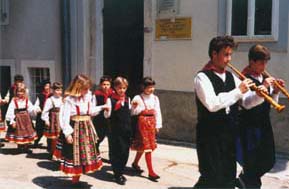
Sopile are important in many situations (from Zasopimo sopile by a famous sopile player Ivan Radic, Matica hrvatska, Rijeka 1995):
What is Istrian scale can be recognized from tuning of a pair of sopile (deep and high voice, or big and small sopela: vela i mala sopela; the Istrian scale is with toni stretti, or in Croatian - ljestvica tijesnih intervala; information by mr. Ivan Pavacic):
- first or mail voice ("na debelo"): E, F, G, Ab, B, Cb
- second or female voice ("na tanko"): C##, D#, E, F, G, Ab
Here we have indeed C## (cisis). Note that we have six pairs of big secunda's.
Over the past several decades only in the USA several hundred tamburitza orchestras were active, with more than 5,000 players. At this moment The Youth Federation of Tamburitza Players in the USA comprises 44 orchestras. Its rich activity is mainly due to the fruitful efforts of the Croatian Fraternal Union (CFU) (Hrvatska bratska zajednica) and its president Bernard Luketich in Pittsburgh. Except in Croatia and the USA, numerous tamburitza orchestras exist among Croatian diaspora in Austria, Switzerland, Germany, Hungary, Scandinavia, South African Republic, Australia, New Zealand, Canada and elsewhere.
The following photo represents Croatian tamburtza players from Lika, Gorski Kotar and Hercegovina, during their stay in Burnett, Washington, in 1919:
Tamburica links in Austria:
- www.tamburica.at, by Kristijan Karall,
- Tamburaski Orkestar i zbor Pinkovac.
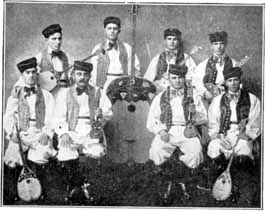
The
Tamburica Croatian Orchestra, 1887
County of Buffalo, Nebraska, USA
(see bchs.kearney.net/BTales_198707.html)
Croats in Punta Arenas, Chile
(Magallanes
region), with their tamburitzas
Croatian tamburitza band
Tomislav in Punta Arenas, 1905
Hrvatsko tamburasko
drustvo Tomislav, Punta Arenas,
1905
(photo from Lj. Antic, Hrvati u J. Americi, Zagreb, 1991, pp 182 and
266, )
It is not widely known that Leo Fender, a famous builder of rock guitars (Fender Stratocaster), used the shape of a Croatian tamburitza head (more precisely, of the so called "brac" or "bas-prim", see below) for his characteristic guitar head. This was a result of Leo's acquaintance with a Croatian room-mate in his student days, who was a tamburitza player. Information by Nenad Bach, who mentioned this this story on his CD "I love losers" (...Leo Fender mentioned in an interview for Musician magazine that he was inspired by the headstock of the tamburitza when he designed the Fender Stratocaster...). And every song on the CD is accompanied with the tamburitza play. Listen to his Can We Go Higher?.
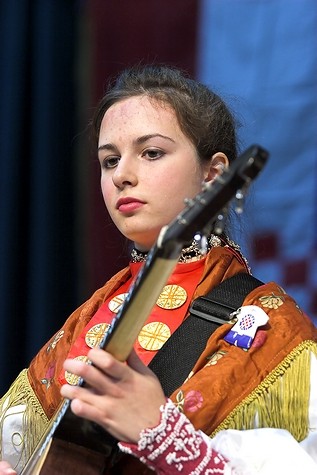
CroatiaFest 2005, Seattle, USA, Photo - Jal Schrof
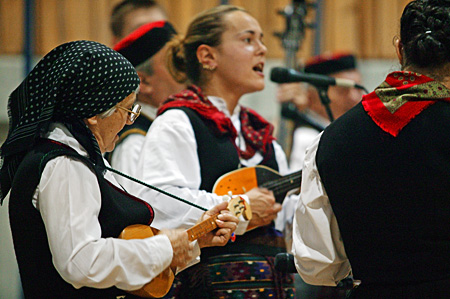
The Lika Night in Bazenheid, Switzerland
two generations of female players of tamburica from Lika
Tamburaski zbor "Kluba uciteljica" (Tamburitza orchestra of Women's Professor's Club, Vrbnik, island of Krk), source: Prof. Mira Katunar, Vrbnik - grad "popi i mestric", Vrbnicki Vidici, p 16, 2006, Vrbnik (photo around 1900?)
Croatia - Austria, an overview of cultural and historical relations - a sketch
